Engineering Immunity Against HIV and Other Dangerous Pathogens
Dr. Pin Wang

Wednesday, September 24, 2008 7 PM
CLU - Richter Hall, Ahmanson Science Building
Viruses are efficient carriers or transport vehicles in the body because they are naturally able to penetrate cells, inserting the genetic material they contain into their new host. By itself, a virus cannot reproduce; it must infect a cell and take control of the host's machinery to make copies. Rather than focusing on conventional vaccines that boost the immune system, Dr. Wang's team is experimenting with a way to help the immune system produce antibodies that can neutralize the virus.
HIV possesses an unusual structure and a keen ability to hide from antibodies in a sugar-coated shield. The shield has very few open spaces on its surface, which makes it virtually impossible to penetrate. Because the virus also has an uncanny ability to hide, HIV often goes virtually unnoticed by neutralizing antibodies that are roaming the body in search of foreign invaders.
Lentiviral delivery vectors must be engineered to target only specific cell type, as seen in A of the diagram. Once the engineered virus encounters HIV, it would inject itself and neutralize the virus. These neutralizing antibodies (B) would immunize the body against HIV over a person's lifetime.
Dr. Ping Wang -
Mork Family Department of Chemical Engineering and Materials Science, University of Southern California
 Pin Wang is Assistant Professor of Chemical Engineering in USC's Viterbi School of Engineering. Wang’s research is part of the Gates Foundation’s Grand Challenges in Global Health initiative, which was launched in 2003 to create "deliverable health tools” that were “not only effective, but also inexpensive to produce, easy to distribute and simple to use in developing countries.” Pin Wang is Assistant Professor of Chemical Engineering in USC's Viterbi School of Engineering. Wang’s research is part of the Gates Foundation’s Grand Challenges in Global Health initiative, which was launched in 2003 to create "deliverable health tools” that were “not only effective, but also inexpensive to produce, easy to distribute and simple to use in developing countries.”
Dr. Wang received a Ph.D. in Chemical Engineering from California Institute of Technology in 2003. Previously, he received a B.S. degree in Material Science and Engineering from the University of Science and Technology of China in 1997.
|


 Pin Wang is Assistant Professor of Chemical Engineering in USC's Viterbi School of Engineering. Wang’s research is part of the Gates Foundation’s Grand Challenges in Global Health initiative, which was launched in 2003 to create "deliverable health tools” that were “not only effective, but also inexpensive to produce, easy to distribute and simple to use in developing countries.”
Pin Wang is Assistant Professor of Chemical Engineering in USC's Viterbi School of Engineering. Wang’s research is part of the Gates Foundation’s Grand Challenges in Global Health initiative, which was launched in 2003 to create "deliverable health tools” that were “not only effective, but also inexpensive to produce, easy to distribute and simple to use in developing countries.”